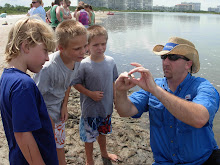 |
| some victims of the recent fish kill in Naples, FL |
Why does the water appear to be discolored in some areas?
When environmental conditions are "just right" (i.e. the right nutrient levels, currents, winds, water temperature, etc) many types of microscopic organisms called phytoplankton (i.e. dinoflagellates and dioatoms) can quickly proliferate or "bloom" into dense visible patches along the water's surface. These blooms can span several kilometers in some cases. Because of the pigments in these organisms' bodies some blooms can cause the water to appear greenish, brown, black or even reddish orange if the concentrations are high enough. This is where the term "red tide" comes from although many red tide events and other algal blooms result in no changes in water color at all.
What causes the fish to die?
 |
| A dead butterfly ray along the beach |
How long will this last?
While some algal blooms can occur for months, it is impossible to know for sure how long the current bloom will last. Initial indications, however, suggest it is already diminishing. It is likely, though, that marine life will continue to wash up on beaches in the next several days.
Is it safe to swim in these waters?
Generally speaking yes, but this usually depends on people's tolerance to swim around dead fish! The County has not closed any of the beaches are issued any health warnings; remember, the species thought to be responsible for this bloom are not considered toxic. Some people, however, have been known to develop skin and eye irritations when swimming in waters with other types of algal blooms. When in doubt, stay out!
Safety Precaution!
 |
| Juvenile sharks affected by the low oxygen conditions swimming in the surf zone |




No comments:
Post a Comment